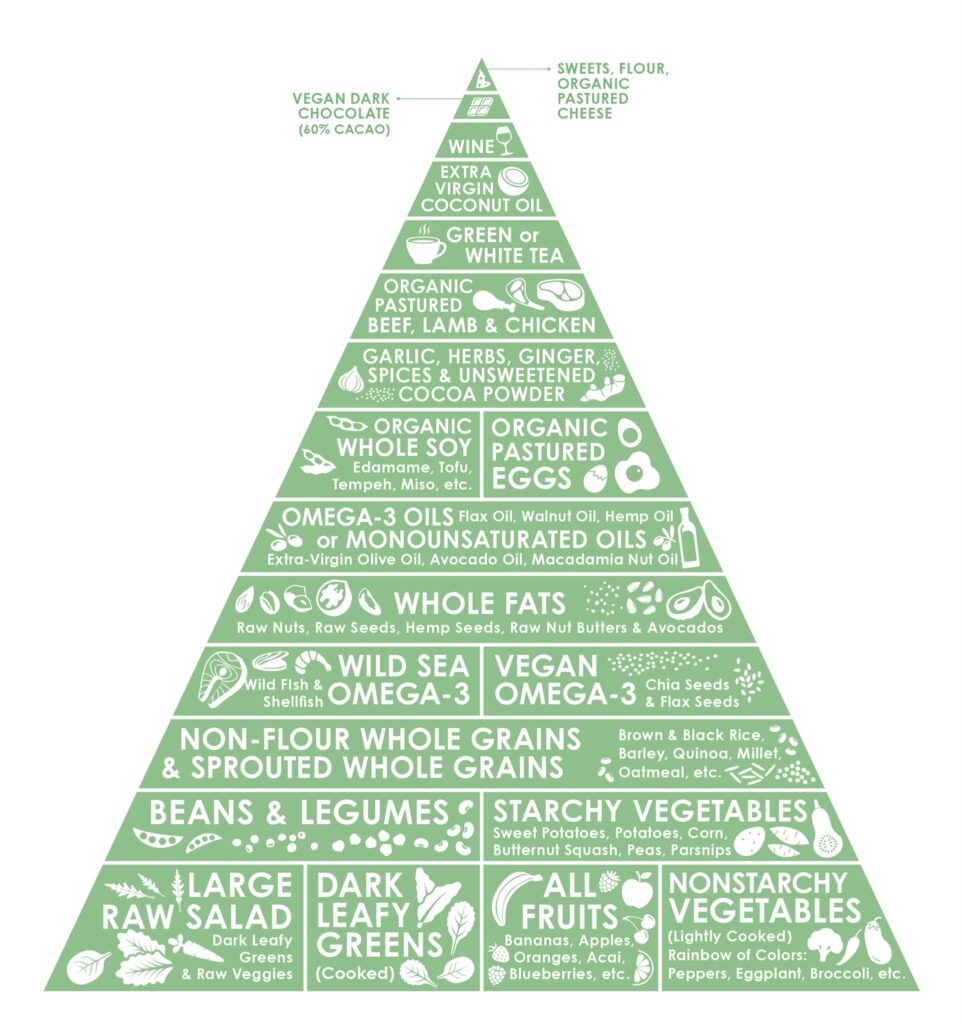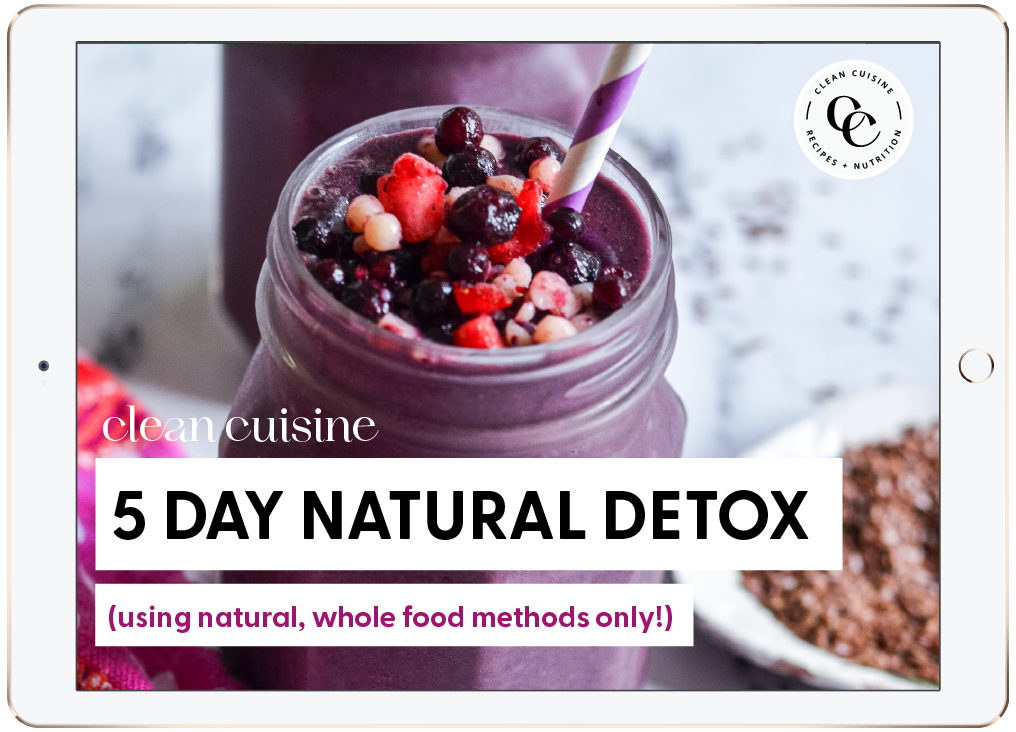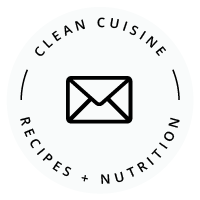10 Clean Cuisine Do’s and Don’ts
- Eat fruits and vegetables with every meal.
- Think plant strong.
- Consume land and sea Omega 3’s.
- Replace refined processed carbs with nutrient-dense carbs.
- Remove trans fats.
- Cook with unrefined oils (and use less oil in general).
- Eat more beans and legumes.
- Switch to plant-based milks.
- Consume more prebiotics and fermented probiotics.
- Only eat when you’re hungry (Note: We are big supporters of 12-hour intermittent fasting)
Clean Cuisine Food Pyramid

More Clean Cuisine Defined Information
What is the Clean Cuisine Definition of Clean Eating?
Clean Cuisine is designed to do two things:
1. Reduce inflammation.
2. Optimize nutrition.
Our definition of clean eating is a diet based on anti-inflammatory foods packaged in their most natural and nutrient-rich state.
This means you want to choose whole foods that are unadulterated…just the way nature intended. You want to go for corn instead of corn flakes, steel cut oats instead of a granola bar that is “made with oats” (but also made with a bunch of empty calorie high fructose corn syrup, processed corn oil, etc.) If push came to shove, you would even want to choose whole olives over olive oil.
The closer a food is to its natural state, the healthier it will be.
Clean Eating = More Plants, Less Animal Food
When it comes to clean food, it’s also important to remember plant foods are lowest on the food chain and therefore contain considerably fewer toxins than animal foods.
Unrefined plant foods are also the only source of anti-inflammatory, anti-aging phytonutrients, which play a key role in the health benefits obtained from eating Clean Cuisine. Phytonutrients are substances that protect the plant and fortify it against illness, but they also offer invaluable disease protection and anti-inflammatory benefits to YOU, the plant-eater. Phytonutrients act in a myriad of health-promoting ways. Many phytonutrients are sources of natural anti-aging antioxidants and others act as powerful inflammation extinguishers. Some phytonutrients enhance immune function and promote healing. Others stimulate enzymes that detoxify cancer-causing carcinogens. In a nutshell, the more phytonutrients you can manage to get into your diet, the better! And the only way possible to get more phytonutrients is to eat more plants and less animal foods. There’s just no way around it. Thus, Clean Cuisine places a heavy emphasis on plant-based nutrition.
However, Clean Cuisine is not vegan either (click HERE to read why). We still allow modest amounts of high-quality animal foods (such as grass-fed beef or pastured eggs) as part of Clean Cuisine, it’s just that we suggest the bulk of your daily calories should come from phytonutrient-rich plant-based unrefined foods (lots of vegetables, fruits, unrefined whole grains, beans, seeds, nuts, legumes, etc.).
Seafood is also encouraged on the Clean Cuisine anti-inflammatory diet because it is so rich in anti-inflammatory omega-3 essential fats. When it comes to reducing inflammation, the dietary fats you eat (or don’t eat) make the biggest impact; and omega-3 fats are the most anti-inflammatory fats of all, so they play a very important role in our Clean Cuisine nutrition recommendations.
In the Clean Cuisine nutrition book we go into great detail explaining the principles and research behind our nutrition advice, but this food pyramid below is a good visual guide to how we build a clean eating meal plan.
Who developed Clean Cuisine?

Clean Cuisine is an anti-inflammatory nutrition program originally developed by Ivy and Andy Larson, M.D. Research into the program began soon after Ivy was diagnosed with an autoimmune disease, multiple sclerosis (MS), in 1998 at the age of twenty-two. At the time of her diagnosis, Ivy’s neurologist at the University of Miami, the late Dr. William Sheremata, made the highly unusual recommendation for her to follow an anti-inflammatory diet to slow the progression of the disease. Although Andy was finishing medical school at the University of Pennsylvania during this time, he had not been taught about the connection between diet and disease and was admittedly a bit skeptical of treating an autoimmune disease as serious as MS with diet. Nevertheless, Andy dug through the medical literature with an open mind and it soon became apparent MS was not the only disease made worse by inflammation. In fact, inflammation is now being linked to just about every health condition. Examples of inflammatory diseases include rheumatoid arthritis, cancer, heart disease, diabetes, asthma, fibromyalgia and even Alzheimer’s.
So, while MS was the initial focus of Ivy and Andy’s nutrition research, the Clean Cuisine program is helpful for anyone suffering with an inflammatory or autoimmune disease. The program was first tested on a group of fifty people suffering with ten different inflammatory and autoimmune diseases at the Red Bank Atlantic Club in New Jersey and after 5-weeks every single person in the program saw improvement in their inflammatory condition along with additional “side benefits” of weight loss, reduced blood pressure, reduced triglycerides, reduced CRP levels and lower body fat. The results of that first program landed Ivy and Andy their first book deal, the best-selling Gold Coast Cure (HCI Books, 2005), which was translated into seven different languages.
Ivy and Andy have since written four additional books on anti-inflammatory nutrition, including Clean Cuisine: An 8-Week Anti-Inflammatory Nutrition Program to Change the Way You Age, Look and Feel and the Clean Cuisine Cookbook. Ivy has shared her story on Good Morning America, CNN, Fox News, The Doctors , the Montel Show, Lifetime Television and in numerous national print media outlets, including TIME, U.S. News and World Report, Oprah magazine, Woman’s World, Woman’s Day and many more.
The Clean Cuisine nutrition program has helped tens of thousands of people and has enabled Ivy to keep her MS symptoms in remission without the need to take disease-modifying medications for over two decades.
Who run Clean Cuisine now?
Aimee Harris Niedosik and Madison Suttles
In January 2020, Ivy and Andy turned the Clean Cuisine website over to Aimee Harris Niedosik and Madison Suttles from Autoimmune Sisters. Although Ivy and Andy are no longer involved with the Clean Cuisine website on a day to day basis Aimee and Madison strictly adhere to the core tenets of the original Clean Cuisine anti-inflammatory nutrition program and are committed to helping individuals suffering with autoimmune diseases regain their health and lives.
What is the science behind Clean Cuisine?
The science behind Clean Cuisine was initially inspired by the work of the late Dr. Roy Swank, the first neurologist to make a connection between diet and multiple sclerosis. Ivy’s neurologist, Dr. William Sheramata, a department chair at the University of Miami, initially told Ivy about Swank’s research on the same day he diagnosed her with MS.
Dr. Swank’s research dates back to 1948, long before modern disease-modifying MS drugs were available. Over the course of a nearly fifty-year career Dr. Swank worked directly with thousands of MS patients and his diet has been proven to reduce the frequency and severity of flare-ups in MS patients. After a period of five years the study patients who followed his diet functioned better than when they were first diagnosed with MS. After twenty years most of the control-group patients were unable to walk whereas the typical Swank patient was fully mobile and experiencing only mild symptoms. The current edition of Dr. Swank’s book, published in 1987, provides irrefutable evidence that diet can in fact improve symptoms of multiple sclerosis. Large-scale studies published in prestigious medical journals such as the Journal of Neurology, Neurosurgery, and Psychiatry, smaller-scale studies published in less widely known journals, basic science studies, and high-quality epidemiological studies have all linked the improvement of MS in real-life humans (not rats, not mice, not chimpanzees) with dietary changes.
The initial research into the Clean Cuisine lifestyle was undertaken at the University of Pennsylvania’s medical library while Andy was finishing medical school in 1998. At that time, Andy was almost done with medical school and had not been taught about the connection between diet and MS. He sought to confirm Dr. Swank’s research truly held up in the twenty-first century and made the effort to look only at studies involving humans and only at studies with the best possible academic foundation; cohort studies and randomized blinded studies were given the most attention and when these were not available only the largest and most statistically significant observational studies were scrutinized and included in the Clean Cuisine lifestyle. Test tube studies, basic science research, and animal studies were avoided because we wanted to be sure all our recommendations would be valid for real life people in real life situations.
While Dr. Larson’s initial efforts were aimed solely at helping his soon-to-be-wife control her MS it quickly became obvious that healthy living and eating affect a vast number of modern disease conditions. He learned that cardiovascular disease is related to blood vessel inflammation and could be controlled by diet much more effectively than it can be controlled with medication. He learned that MS was not the only autoimmune condition that is made worse by inflammation.
Ultimately, the only reasonable conclusion Ivy and Andy could make was that every person suffering from an autoimmune condition, inflammation-mediated condition, or cardiovascular condition would stand to benefit from the Clean Cuisine anti-inflammatory nutrition program. Not only that but every person who wishes to avoid being diagnosed with these conditions stands to benefit as well. Again, only human research was reviewed in coming to this conclusion and only the most definitive studies from the most prestigious research journals were included as references in their several bestselling books.
From a scientific standpoint it is important to understand the human body is an intricate tool and although the symptoms of each disease condition differ from person to person and might be made worse based upon genetics and environmental exposures each one of us does have control over the types of foods we eat. Nutrition affects the amount of inflammation in our bodies and the vast majority of chronic modern diseases are made worse by inflammation. The best way to prevent or control modern chronic disease is to follow an anti-inflammation lifestyle such as the Swank Diet or, better yet, to follow our delicious optimized version of this diet that we carefully researched and ultimately turned into Clean Cuisine.
Are all calories created equal?
No, all calories are not created equal.
In addition to reducing inflammation, Clean Cuisine is also all about boosting nutrition and eating nutrient-dense foods. To understand the concept of nutrient density, it is important to understand the difference between macronutrients and micronutrients.
Macronutrients are the calorie-containing substances that give us energy: carbohydrates, fats and proteins. The Nutrition Facts labels you see on food products make it appear as though all carbohydrates, fats and proteins are equal. This is not the case.
There are good, healthful unrefined sources of carbohydrates, fats and proteins and then there are bad, unhealthful and highly processed sources too. Whole grains, fruits, and vegetables are excellent sources of carbohydrates and should absolutely be an integral part of any clean eating meal plan. High fructose corn syrup, enriched or all-purpose flour and white rice are all examples of nutrient-poor, pro-inflammatory carbohydrates. Just because an apple might have the same number of calories as a slice of white bread does NOT make the two nutritionally equivalent! Raw nuts, flaxseeds and avocados are all good, anti-inflammatory and nutrient-dense sources of fat and should also be included in clean eating recipes and meal plans. On the other hand, vegetable oil, margarine and vegetable shortening are all nutrient poor and pro-inflammatory fats and should be avoided. When it comes to protein, foods like fish, nuts, seeds, beans and “whole” soy (such as tempeh or edamame beans) are nutrient-dense. Isolated soy protein, hot dogs, milk and cheese are all nutrient-poor and pro-inflammatory sources of protein. In short, the best sources of macronutrients are unrefined whole foods, primarily (but not exclusively), from plants.
Keep in mind, the micronutrients in food do not contain calories (energy) and do not directly provide energy, but they do play a tremendous role in optimizing health and even appearance. Micronutrients consist of vitamins, minerals, antioxidants and phytonutrients. Modern diets are highly deficient in micronutrients. Although it is true highly processed modern foods such as enriched flour and most breakfast cereals are often fortified with synthetic vitamins and minerals, these man-made versions are not recognized or utilized by your body in the same way as naturally-occurring vitamins and minerals found in whole foods.
In addition, although processed foods may be fortified with synthetic vitamins and minerals, they are not fortified with all the other good things found in unrefined whole foods, such as antioxidants and phytonutrients. These anti-inflammatory compounds are destroyed during food processing and are not added back. And even if a food does happen to be fortified with an individual isolated phytonutrient, such as a lycopene-fortified beverage, your body does not recognize or utilize the isolated substance in the same manner it would if the phytonutrient had been consumed as part of the whole food. Without question, phytonutrients found in their “whole food” form are superior.
Does Clean Cuisine believe in counting calories?
Don’t Count Your Food, Make Your Food Count!
Although there are plenty of clean eating enthusiasts who might disagree, we don’t support the concept of “counting food” in the form of macronutrients (carbs, fats and protein). Instead, we prefer to put the emphasis on “making food count” through optimal intake of micronutrients (vitamins, minerals, antioxidants and phytonutrients).
Instead of restricting calories or portions, you’ll find our clean eating meal plan recommends changing the proportion of the dinner plate to emphasize unrefined plant-based whole foods and deemphasize animal foods. In a “Clean Cuisine” recipe, foods such as meat and chicken are used more as condiments and flavor-enhancers rather than taking center stage at the dinner plate. And we incorporate a LOT of fruit and vegetables into our diet and recipes. For example, in our Clean Cuisine Cookbook, every single recipe sneaks in a fruit, vegetable or superfood. These subtle changes to our clean eating recipes and meals do not change the flavor or the enjoyment you’ll get from your meal, but they radically enhance the nutritional profile and help reduce inflammation.
One thing that really sets Clean Cuisine apart from other clean eating diet programs is our understanding of the that fact the only way people are going to get the results they are seeking from changing their diet is if they make a lifetime commitment. Doing a 60 day “cleanse” or detox program and then reverting right back to your old eating habits is not going to give you long-term results. However, a lifetime of clean eating can be daunting if it is overly restrictive or if the food doesn’t actually taste good. And that’s where Clean Cuisine is very different from other “clean eating” programs.
What is the primary goal of the Clean Cuisine lifestyle?
Our primary goal is life-enhancement; we want to enjoy our life maximally in every way possible.
Clean Cuisine is all about eating the absolute best-tasting and most flavorful food. Furthermore, we are strict when and where it counts most and lenient where it doesn’t matter so much. Our approach to clean eating is balanced and we promise eating this way will not decrease the pleasure in your life. And eating Clean Cuisine does not mean adopting a radical way of eating either. In fact, we are not convinced that radical diets are optimal for health either.
For example, we do borrow many cooking techniques and nutrition recommendations from vegan and raw food experts and we enjoy an abundance of vegan and raw food meals in our own diets, but as mentioned above, we are not vegan. The primary reason we are not vegan is that if you dig deep into the nutrition research you realize that people who eat primarily vegan “whole foods” diets but also include a bit of fish, eggs and lean meats are every bit as healthy—if not more so—than those who follow a pure vegan diet. Additionally, we absolutely cannot find any scientific support for eliminating omega-3 rich fish from your diet either. Instead, what the medical research shows is that while it is true vegetarians have fewer heart attacks, less incidence of cancer, less obesity, lower body weights, less high blood pressure, and longer life spans in general, individuals who are not super strict at avoiding animal foods enjoy equally impressive health benefits across the board as long as the bulk of their calories come from whole plant foods with an abundance of fruits and vegetables. In other words, the less radical approach to clean eating seems to not only be the easiest and tastiest approach, but is potentially the healthiest as well.
In short, Clean Cuisine bridges the gap between what we should eat, what tastes good, what is best for our bodies and what is actually doable in the real world. We encourage a sustainable way of eating that is in sync with the needs of our bodies and the environment.





Homemade Cranberry Sauce with Orange and Ginger
Monday 29th of March 2021
[…] Clean Cuisine Defined […]